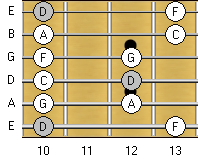In this lesson we’re going to look at one of my favourite ways of practising the minor pentatonic scale. It involves taking a scale fingering, and then playing through it using a melodic pattern. This means that rather than playing the scale straight up-and-down, you’ll play a repeating melodic idea that uses notes from the scale.
It’s probably a good idea if we look at a specific example of what I mean by this. That way you’ll have a clearer idea of exactly what I mean by melodic pattern.
An Example
For this example, we’re going to use the first fingering of the D Minor Pentatonic scale…

Please take some time now to play through this fingering a few times. Once you’ve done that, then please check out the exercise below…
Minor Pentatonic Melodic Pattern Exercise 1:

Please take a few minutes to play through this exercise slowly. What melodic pattern do you think is being used?
Analysing The Melodic Pattern
I think it’s always a good idea to work out the notes of everything that you learn from TAB. By doing that, you’ll be more likely to understand the musical meaning of what you’re learning. So let’s take the exercise and work out all the notes that are being played…

With the exception of the last note, there’s a very clear pattern being used. I like to call this melodic pattern descending threes, although you’re free to call it whatever you want. The key thing is that it’s a three note melodic pattern that allows you to descend through the notes of the scale in a very cool way. It’s certainly a lot more interesting than just playing the scale without the pattern!
Oh yeah, before I forget. The reason why I added the very last note in is because I liked the sound of it. Just because it’s an exercise, doesn’t mean that it shouldn’t sound good. Of course, if you don’t like how I ended the exercise, then just leave out the last note, or make up your own ending. 🙂
Practising The Melodic Pattern
Now that we’ve talked a little bit about the pattern, let’s do some work on it. To help you do that I’ve written out the exercise below with some picking and fingering suggestions…

You don’t have to use the same fingers or pick motions as I’ve written above. But if you use what I’ve suggested, then you’ll find that it makes for a fantastic alternate picking workout. It’s also exactly how I play the exercise on the video. So if you use the same as what I’ve written above, it will relate better to what’s being demonstrated on the video below…
Why It’s Important To Practice Melodic Patterns
You might be wondering about why you should practice melodic patterns. In my opinion, some of the main benefits of doing it are…
- They’re more interesting to practice. Scales have a reputation of being boring to practice. And if you just practice them in normal way, I would agree. (It’s very rare that I practice a scale in a straight up-and-down manner). By using a melodic pattern it makes the scale sound a lot more musical and far less boring.
- It trains your fingers to “shuffle” up the notes of the scale. The eventual goal of scale practice is to make music with the scale. By learning to play melodic patterns you’ll develop a more flexible technique that will help you when it comes time to improvise. If you only practice a scale straight up-and-down it’s unlikely that your fingers will be able to mix up the notes of the scale in a non-linear way.
- They’re more challenging technically. If you’ve already got good technique, playing a scale normally isn’t that hard. But by using melodic patterns you can continually challenge yourself—especially if you learn melodic patterns that are hard to play. This means that you can continually develop your technique by learning new melodic patterns.
- They help develop your ears. By practising different melodic patterns you’ll internalize the sound, and finger movements of a wide range of melodic ideas. This has tremendous value because it helps you to build the connection between what you hear in your head and the guitar fretboard, which is an incredibly important skill to develop if you want to become a good improviser.
- They help you build your soloing vocabulary. When you’ve practised a melodic pattern enough, you’ll find that it starts creeping into your playing when you improvise. This means that if you master a wide range of melodic patterns, you’ll be able to expand your soloing vocabulary in a very drastic way.
A Few Last Words
OK, that’s all for now. Please take some time to practice the melodic pattern. And don’t forget that when you can play the melodic pattern fluently in Fingering 1, you can also try playing through the other four minor pentatonic fingerings using it.
Have fun!
Return To: Guitar Technique Lessons
